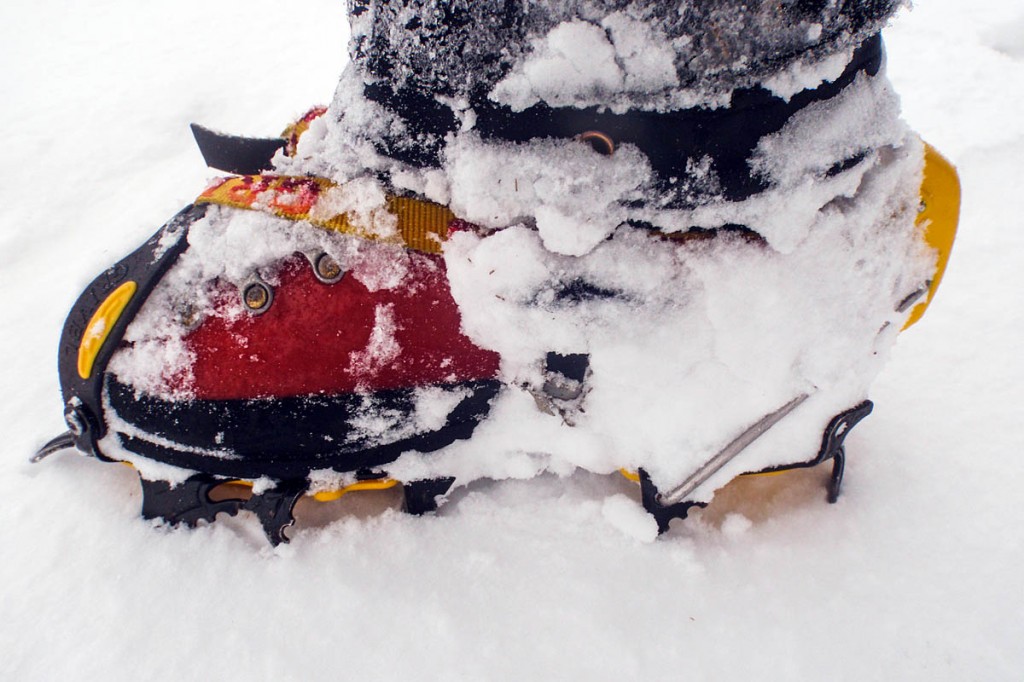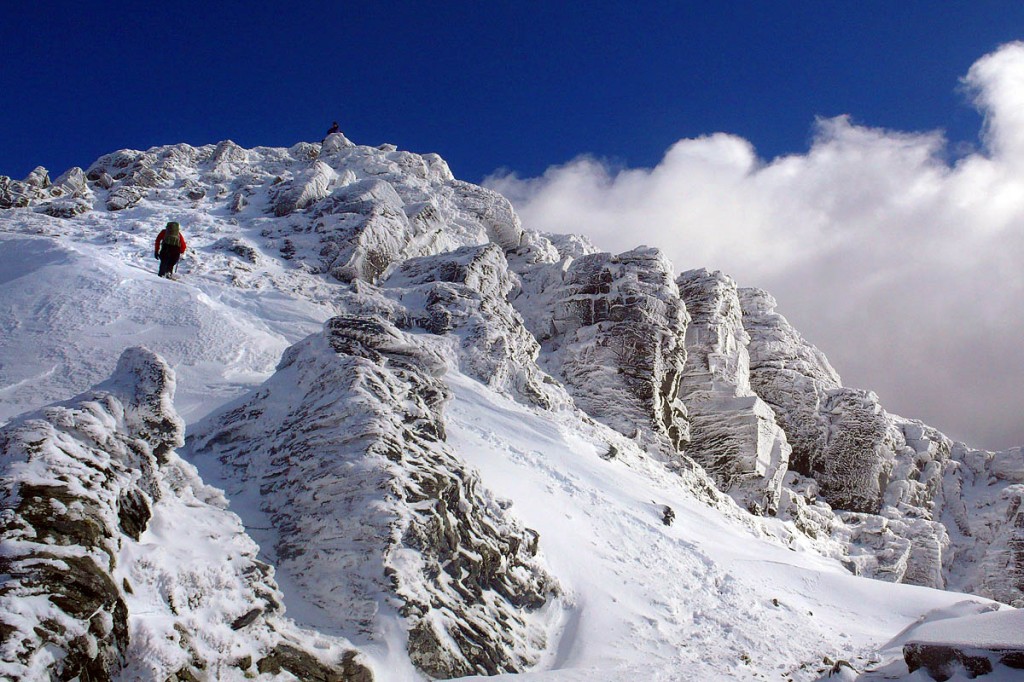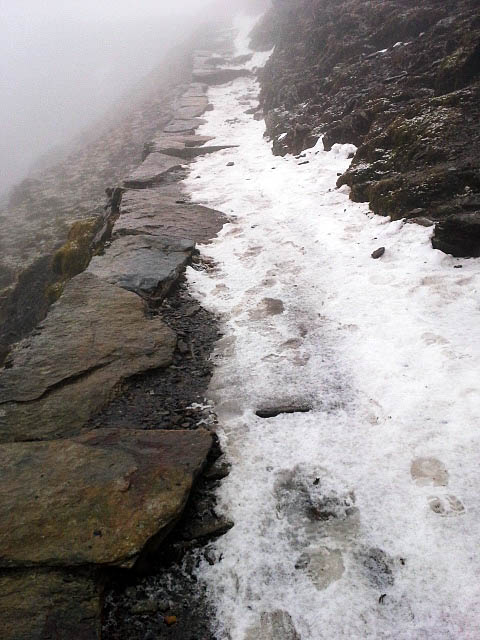Experts in Scotland and Wales are warning of the dangers of ill-prepared walkers going on to the mountains this Easter.
The high mountains in both nations are still in winter conditions and crampons and ice-axe are essential pieces of kit for hillgoers heading for the tops.
The Mountaineering Council of Scotland appealed to people to stay away from the high mountains unless they are properly equipped and experienced.
The council said: “The Easter weekend is traditionally a busy time in Scotland’s mountains, with thousands of enthusiastic hillwalkers making their first visit to the mountains since the end of winter.
“However an early date for Easter and continued wintry conditions in the mountains – fresh snow has still been building up this week – has left some mountain rescuers with serious safety concerns for the weekend ahead.
Heather Morning, mountain safety advisor for the MCofS, said: “Sadly, during the month of March this year, three people lost their lives in the Scottish mountains. They weren’t attempting severe ice climbs; they had set off to enjoy a hill walk up one Scotland’s many Munros.”
The MCofS warned people of the dangers of heading for the hills with inadequate equipment or experience.
The warning was endorsed by David Dodson, leader of the Lomond Mountain Rescue Team, who said: “Lomond Mountain Rescue Team would like to stress that, despite the spring-like conditions at lower levels, it is still very much mid-winter high on the hills and it is vital to head out prepared with essential safety equipment and – equally important – having the mountaineering skills to use them”.
Simon Steer, chair of Scottish Mountain Rescue, added: “It’s a sad fact that the beautiful, yet deceptive conditions on the hills at Easter means that this is often a busy time for the volunteers in the mountain rescue teams. We hope that hill-goers will heed advice of the MCofS to avoid getting into difficulties which can place both themselves and their rescuers at risk.”
Continuing cycles of freezing and thawing through the winter turns old snow ice-hard, making it impossible to keep one’s feet without proper crampons and turning a slip into a slide which can lead to serious or fatal injury as the victim is taken over rocky ground or cliffs, the MCofS said.

Crampons are an essential piece of kit for anyone heading for the mountain tops, experts said. Photo: MCofS
Ms Morning said: “If you are heading above 600m this Easter you must take an ice-axe and crampons. And rigid-soled boots must be worn to kick steps across old, hard snow patches.
“Don’t be fooled into thinking that a pair of lightweight slip-on snow-spikes will do the job. They won’t. Crampons that are not securely clipped and strapped to your boots will roll off as soon as you leave flat ground.”
There was a similar message from the MountainSafe organisation in Snowdonia, as the national park gears up for an influx of visitors over Easter.
A spokesperson said: “As clocks have turned, daylight increases and spring begins to show its colours, MountainSafe is encouraging all walkers to check the weather forecast before setting off to the mountains this Easter.
“In a recent survey, it was found that only 43 per cent of those surveyed checked the mountain weather forecast before setting out for the mountains. Therefore, this Easter, MountainSafe is encouraging walkers to check weather forecasts which are aimed specifically at walkers.
“More often than not, the weather on the mountains is completely different to the weather in the lowlands. On average, the temperature drops about 1 to 3C for each 300m that is climbed. Therefore, while it’s 7C in Llanberis, it can be –3 C on the top of Snowdon.”
Helen Pye, the national park warden on Snowdon said: “We want everyone who comes here to enjoy the experience of walking in the mountains of Snowdonia.
“Therefore it’s essential to check weather forecasts which are specifically aimed at walkers, to decide if the weather is suitable for hillwalking and to pack the right gear for the forecast conditions.”
Phil Benbow, chair of the Mountain Safe Partnership and a member of the Llanberis Mountain Rescue Team, said: “In order to alleviate some of our work, we ask everyone to consider and remember: Hafod Eryri is not open over the Easter holidays, so there will be no shelter or food or drink available at the summit.
“Walking in bad weather can be very exhausting, so make sure that everyone in the group is fit enough for the journey.
“We’re not asking people not to venture out in bad weather, just asking people to check the mountain weather forecast and consider venturing on a less challenging walk in Snowdonia if the weather isn’t suitable for the mountains.”
MountainSafe pointed out weather hazards mountain walkers could face over Easter:
- Snow: very often snow remains on the mountains until the end of April, and when there’s snow on the footpaths, you will need the correct equipment, including an ice-axe and crampons
- Wind speed: you’ll need to check wind speed in advance as walking in high winds or gusting wind is very difficult and can be incredibly tiring
- Rain: even if the weather looks favourable, you need a coat, waterproof trousers, and good walking shoes. Wet clothes will very quickly make you much colder and rain can make paths very slippery underfoot
- Sun: strong sun leads to sunburn and dehydration, so you’ll need sunscreen, a sun hat and plenty of water.
MountainSafe is a partnership between North Wales Police, Snowdonia National Park Authority, North Wales Mountain Rescue Association, British Mountaineering Council, Mountain Training Wales, Llanberis Mountain Rescue Team, the Met Office, Royal Air Force 22 Squadron, Plas y Brenin National Mountain Centre and Snowdonia Active.
More safety details are on the MountainSafe website and the Mountaineering Council of Scotland site.
Mountain weather forecasts can be found on the Met Office site and on the Mountain Weather Information Service.


Paul Gannon
01 April 2015Nice sentiment, but no one who needs to read all of the long statements above is going to do so & the media will boil it all down to a counter-productive (and economically damaging) 'keep off the mountains' headline. It needs an understanding of how the media works and how not to put out overlong, unfocused and ultimately ineffective messages.
Ian512
01 April 2015I wonder who it's aimed at:-
"walkers . . "everyone who comes here" . . "people."
Any competent mountaineer will not need to be reminded of the issues highlighted above; so just who is being targeted?
Block Rockin\' Pete
01 April 2015"It needs an understanding of how the media works and how not to put out overlong, unfocused and ultimately ineffective messages."
Right, so you are saying we need somebody who can distill long winded, dry and boring information into a useful, practical and concise, easily digestible material?
Hey, it's Paul Gannon!
Richard Warren Lakes MR
01 April 2015An interesting and thought provoking article and the comments from Ian and Paul ring true. I am sat here thinking about how to tackle the problem from a UK perspective after two radio interviews and two TV interviews this week in the run up to Easter specifically focussing on need for preparation, equipment and skills. The people we need to target don't even know about grough. We can tweet relevant grough articles which does get out to the non mountaineering community but articles and signs do not stop DoE teenagers getting tents blown down in severe gales when amber warnings are in force. We do need to understand why people will still take to the high ground even when conditions would turn back experienced mountaineers and fell walkers. These are the questions that need to be tackled.
There may not be a solution. If there is no solution then we need to prepare our team members and leaders to fully understand what we are committing to when we join MR.
I will reflect on all of the above as I have to believe there is a solution. We can prevent loss of life and distress if we try. All ideas welcome.
Ian512
02 April 2015Richard, good points.
There have been significant changes with regard to the people who are using the hills and finding a solution to the increasing number of call-outs will be a big challenge.
I wrote in another recent post:-
'Commercial interests, governing bodies and other interested parties seem to be in a dilemma between heavily promoting the activity as a sport, while at the same time have to regularly remind people that it is in fact a potentially dangerous activity. When taking part in a sport you can usually call it a day whenever you wish – though is that not what many people now do on the hill, call it a day by calling the local Rescue Team.'